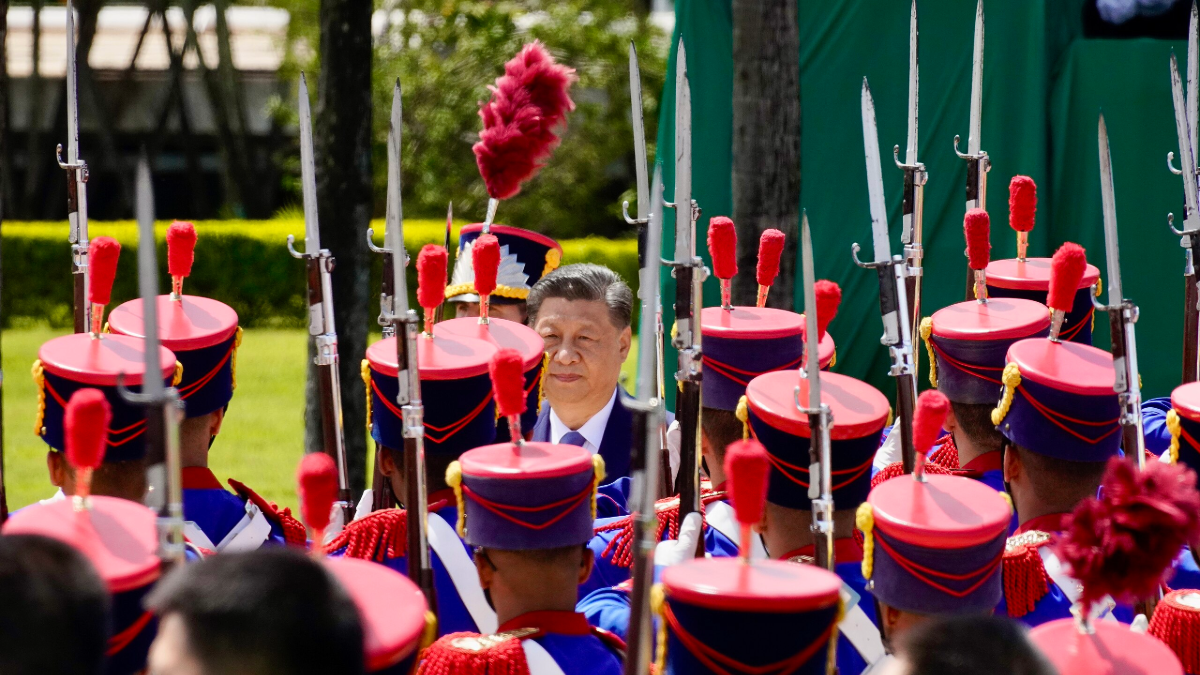Chinese President Xi Jinping at the Alvorada Palace in Brasília in November 2024. Photo: Cadu Gomes/VPR/CC 2.0. Source
As China competes with the US for technology supremacy, policymakers and market watchers often focus on the race between firms in both countries in terms of technological and market development. However, equally important is understanding how China governs its Internet, and by extension, the companies operating in that space. This spans a wide range of services, including traditional internet services, social media, online games, and artificial intelligence. So, how does China govern its internet ecosystem, and what does that mean for the rest of the world?
The first thing most people think of when considering China’s Internet governance is the Great Firewall. But for China, it is much more than simply a firewall to “keep things out.” China has been gradually developing its governance model since it was connected to the global Internet in the mid-1990s, with a highly centralized, state-driven model that combines control over its technical infrastructure and legal frameworks with strong ideological control. As the model is refined over the decades, China has become ready to export it internationally, including through its Digital Silk Road initiative, which expands its technology influence globally through both Chinese products and services as well as financial incentives.
A critical part of China’s effort to centralize its control on Internet policies has been through the establishment of the Cyberspace Administration of China (CAC), first set up in 2011 as the State Internet Information Office (SIIO) — a subgroup under the State Council Information Office (SCIO) — which is an external name of the Office of External Propaganda (OEP) of the Chinese Communist Party. In 2014, the SIIO was renamed externally in English as the Cyberspace Administration of China, and was firmly put in place as the de facto centralized Internet regulator to direct and coordinate all legal, ideological, and technological control.
Insights from CAC’s recent report
The recent publication of China’s Internet Governance Development Report by the CAC in April 2025 offers some useful insights into how China’s internet governance operates today. A direct translation of the title of the report should be “China’s Internet Rule of Law Development Report.” However, although the term “法治” is commonly referred to as “rule of law” in English, China’s use of this term is generally agreed to be better characterized as rule by law. In China’s context, this refers to a system where the state uses laws as a tool for governance, rather than adhering to the principle of laws limiting state power.
Moreover, the report’s content extends beyond the legal application of China’s internet regulations. It also covers how to promote this system both domestically (how it is presented to the Chinese public) and internationally (how China promotes its model abroad). For these reasons, the term “governance” reflects the broader system of norms that China is developing and advocating.
The Cyberspace Administration of China, as the policymaker for the country’s digital and online affairs, wields absolute power over China’s internet infrastructure. As both a state agency and the executive arm of the Central Cyberspace Affairs Commission, a party organ chaired by General Secretary Xi Jinping, the CAC plays a crucial role in shaping and enforcing China’s control over its internet. In the report, CAC boasts of having established a way to govern the Internet according to law, which “is both in accordance with international common practices and has Chinese characteristics.” This includes thedirectives from General Secretary Xi in July, 2023, on Internet security and informationization work that the Chinese government must “insist” on “regulating the Internet by law, operating the Internet by law, and using the Internet by law,” referring to the responsibility by the authorities, the operators, and the users, respectively.
The five main chapters of the report clearly describe the narrative of the five elements of the Chinese Internet governance model: expediting legislation, effective execution (including regulations), deepening the enforcement of justice, innovating related education and propaganda for these measures, and, finally, advocating extraterritorial Internet governance.
While the first three chapters align with the branches of government, China emphasizes cooperation and fusion among them, rather than the democratic model of separation and independence.
As for the execution of the law, the report openly states the techniques used by law enforcement, including “consultation by appointment,” issuing a warning, and fines. In 2024, 11,159 websites and platforms were consulted by appointment, 4,046 were given warnings or penalties, and 10,946 illegal websites were ordered to be closed. Also, in accordance with the Cybersecurity Law (2017), Data Security Law (2021), and Personal Information Protection Law (2021), more than 200,000 audits were conducted.
The report also cites the “Clean Network 2024” campaign, in which more than 47,000 people were investigated for rumor-mongering, with over 330,000 accounts suspended and over 2.52 million messages removed. These statistics and descriptions of the enforcement actions offer a glimpse into the nature and scale of the measures China has taken to legitimize its censorship practices to control the Internet.
Taking China’s governance model global
The report attributes the “historic success” of China’s Internet governance to the “Xi Jinping thought,” and promotes China’s Internet rule of law model as a national brand.
The section of the report on extraterritorial Internet governance indeed outlines China’s strategy to actively engage in and create further space for expanding its model to the rest of the world, through proactively constructing platforms for international exchange, building consensus, and promoting its vision of “legalizing” global Internet governance. Here, the report clearly explains the ultimate motivation for China’s effort in this regard: to clearly establish the legal basis and international framework that will allow China to exercise its legal rights transnationally, especially for data processing activities that will infringe on China’s “national security, public interests, and the rights of civil and organizational under law.”
China has long been critical of the existing multistakeholder model of Internet governance, exemplified by the domain name administration system under the Internet Corporation for Assigned Names and Numbers (ICANN), and also for standards setting, such as the Internet Engineering Task Force (IETF), accusing them as privileging to western interests, and leaving governments to only consultative roles. It has long been in favor of an alternative governing structure under multilateral organizations, such as the International Telecommunication Union (ITU) or the United Nations itself, which are represented only by governments.
To that end, China expressly affirms its support for the United Nations as the core international structure for the global governance of the cyberspace, citing its “constructive” input to the United Nation’sGlobal Digital Compact framework proposal, and theUN Convention against Cybercrime that was rectified by the UN General Assembly last December and expected to be signed by member states in a ceremony to be held in Hanoi, Vietnam, later this year. China was a co-initiator with Russia in 2019 with the original proposal. While the treaty aimed to combat the growing issue of cybercrimes worldwide, its language emphasized state control and imposed stricter requirements on private companies to comply with information requests from cross-border government law enforcement. With its broad definition of cybercrime, civil society actors have expressed extreme concern over the potential expansion of cross-border surveillance by state actors and other human rights violations.
In addition to pushing for a stronger UN role in future Internet governance, aiming to shift the current multistakeholder model toward a state-dominated, multilateral system that limits meaningful participation by other stakeholders, China is also building its own forums to promote a top-down, rule-by-law model. This includes bilateral agreements with other countries and regions, as well as platforms it has initiated, such as the Shanghai Cooperation Organization and the World Internet Conference.
Global rule-setting
In the final section of the report, which looks ahead to China’s future vision for Internet governance, the CAC emphasizes the need to leverage China’s new quality productivity forces to address the challenges posed by an increasingly diverse array of social groups, values, and interests. It also highlights the importance of building on the success of the country’s tech sector, exemplified by the “China speed” of firms like DeepSeek, while continuing to refine its Internet legal system to participate in and “lead” global rule-setting.
China’s intention and the strategy of its playbook are clear — to replace the current state of global multistakeholder Internet governance model with a model dictated by only governments. Promoting and exporting a governance framework that favors authoritarian regimes serves China’s party interests and national security goals, aligning with its broader strategy of expanding global influence through diplomacy and norm-setting. And it’s already making headway in international bodies, including the United Nations, with support from allies like Russia. Democracies can no longer afford to ignore this strategy, it is important they recognize and confront the challenge now.


